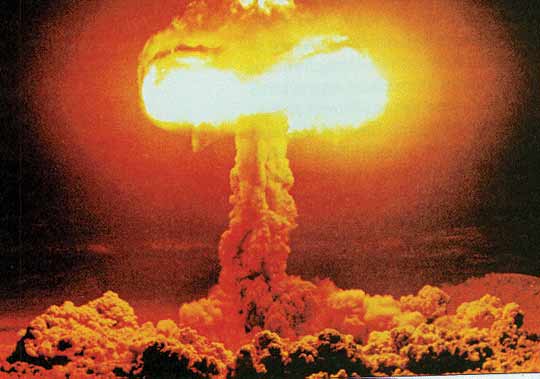Global Zero: The Road Ahead – Analysis
By IPCS
By Shubhra Chaturvedi
While the Global Zero movement started off with high expectations and global enthusiasm for nuclear disarmament, two years later, there seems to be slow progress. Why has it slowed down? What has been achieved so far and what are the grey areas?
Global Zero movement: An assessment
 Launched in December 2008 in Paris, the movement called for a ‘phased’, ‘verified’ elimination of the nuclear threat including proliferation and nuclear terrorism. The Global Zero movement had its aims set, which were to stop the spread of and eliminate all nuclear weapons and secure all nuclear materials. The four horsemen (Henry Kissinger, George Shultz, William Perry and Sam Nunn) attempted to shift the focus from nuclear weapons as essential weapons for possession to other threats to global security like chemical weapons, biological weapons, and climate change, to decrease the value attached to nuclear weapons.
Launched in December 2008 in Paris, the movement called for a ‘phased’, ‘verified’ elimination of the nuclear threat including proliferation and nuclear terrorism. The Global Zero movement had its aims set, which were to stop the spread of and eliminate all nuclear weapons and secure all nuclear materials. The four horsemen (Henry Kissinger, George Shultz, William Perry and Sam Nunn) attempted to shift the focus from nuclear weapons as essential weapons for possession to other threats to global security like chemical weapons, biological weapons, and climate change, to decrease the value attached to nuclear weapons.
The movement not only merged the grassroots initiatives, civil society efforts and dialogues with different states, but also came up with a documentary – Countdown to Zero – to increase awareness towards the issue among all sections of society. Aattempts have been made in all areas to increase the acceptance level of the issue. The Global Zero movement prepared a step-by-step action plan which in its first phase called on the US and Russia to cut their arsenals to a total of 1,000 warheads each. All other countries with nuclear weapons were to freeze their arsenals, and the international community was to conduct a global effort to block the spread of nuclear weapons. In order to fight the mindset of many regarding it as being another tool to re-establish the divide between the ‘haves’ and ‘have-nots’, in 2010, the US and Russia signed the New START Treaty. This was ratified later in 2011, ensuring that the number of deployed strategic nuclear warheads would be reduced by 1,550 for each side by 2017.
At the London Global Zero Summit in 2011, Barack Obama declared that “Global Zero will always have a partner in me and my administration.” These words should have worked as the legitimizing device for the movement.
What are the problem areas?
The problem with the movement is not the lack of interest or initiative, or even the absence of power–backing, with powerful and influential countries and groups propagating and leading the movement. The problem is the failure to disincentivize the ‘possession’ of nuclear weapons itself. While the general disarmament rationale accepts the complete elimination of these arsenals, the initiative is still seen by many as a discriminatory one. The lack of unified support is evident in instances like the current scenario in Iran. Former Russian nuclear missile chief Viktor Yesin said in an ITAR-TASS report, “The process of multilateral nuclear disarmament can be successfully launched only along with the creation of a new security architecture, where all parties to this process have equal guarantees.”
The major problem however is the realization of the feeling of equality. Differences in opinion also affect the movement. As The Economic Times reported, the current Russian President Vladimir Putin unlike his predecessor does not approve of letting go of nuclear weapons, and internal resistance within the US is an additional barrier in the way of Global Zero. Eefforts by the US and Russia have been commendable, yet a crucial aspect of this movement is that like many other nuclear disarmament initiatives, it is seen as an extension of the endeavour by powerful states to contain the ‘others’. Russia even today has approximately 5500 total warheads with 1492 operational strategic warheads while the US possesses approximately 5000 warheads with 1737 deployed strategic warheads, which is still a big number.
The road ahead
According to Achin Vanaik, a nuclear disarmament movement involves two stages – the first involves attacking and undermining popular policies, and the second brings actual changes in the current policies. Creation of popular political perspectives is most important in both these phases. The new change should be accepted at the fundamental level and then should be publicized through propaganda, organizational skills, agitations and so on. The problem with Global Zero inspite of its achievements lies in the second phase where the new change is not accepted beyond the moral realm. The emergence of ‘responsible powers’ like India adds much more to the feeling of psychological resistance and pessimism towards any such efforts, and unintentionally ends up linking nuclear weapons to the currency of power. The need is for a unified construction as well as acceptance of the rationality that believes in the futility of not just use but even the ‘possession’ of nuclear weapons. Such a rationality that is not perceived as ‘Western’ but rather ‘practical’ is awaited.
A major achievement of the movement is that it has shifted the focus from discourses on treaties to serious discussions over possible ways to achieve nuclear disarmament. While the implementation will take its due time, debates and discussions and criticism have ensured that this does not remain a passing discourse. The movement has set the agenda, and a significant step is the revitalization of the nuclear disarmament movement that is visible in the current scenario.
Shubhra Chaturvedi
Research Intern, IPCS
email: [email protected]
